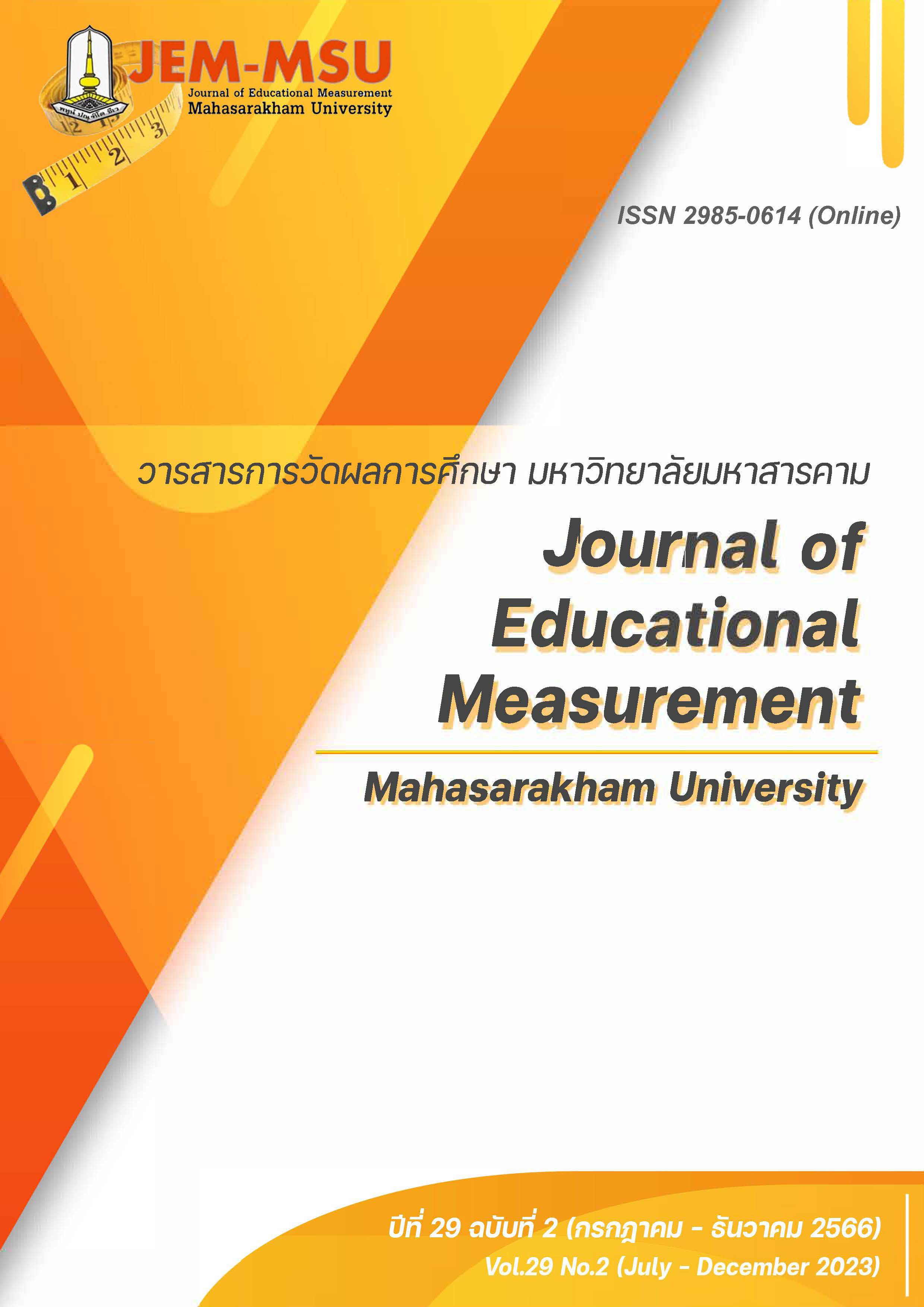รูปแบบการจัดการเรียนรู้เสริมสร้างความสามารถการแก้ปัญหาอย่างมีวิจารณญาณและการคิดวิเคราะห์วิชาวิทยาศาสตร์ของนักเรียนชั้นประถมศึกษาปีที่ 6
Main Article Content
บทคัดย่อ
การวิจัยครั้งนี้มีความมุ่งหมายเพื่อ 1) พัฒนารูปแบบการจัดการเรียนรู้เสริมสร้างความสามารถการแก้ปัญหาอย่างมีวิจารณญาณและการคิดวิเคราะห์ของนักเรียนชั้นประถมศึกษาปีที่ 6 2) ทดลองใช้ร่างรูปแบบการจัดการเรียนรู้เสริมสร้างความสามารถการแก้ปัญหาอย่างมีวิจารณญาณและการคิดวิเคราะห์ของนักเรียนชั้นประถมศึกษาปีที่ 6 ตามแนวคิดการสืบเสาะหาความรู้ การให้เหตุผล และทฤษฎีการสร้างองค์ความรู้ การวิจัยครั้งนี้ใช้กระบวนการวิจัยและพัฒนา ในบริบทสถานศึกษาของเทศบาลเมืองนครพนม จังหวัดนครพนม ปีการศึกษา 2564 จำนวน 4 โรงเรียน ประกอบด้วยครูผู้สอนวิชาวิทยาศาสตร์ 4 คน และนักเรียน 215 คน โดยดำเนินการวิจัย ระยะที่ 1 การพัฒนารูปแบบ โดยการสัมภาษณ์ครูผู้สอน 4 คน และนักเรียน 12 คน และสังเกตพฤติกรรมการเรียนวิชาวิทยาศาสตร์ของนักเรียน จำนวน 4 ห้อง ซึ่งได้มาด้วยวิธีการเลือกแบบเจาะจง รวมทั้งจัดกิจกรรมสนทนาอิงผู้เชี่ยวชาญ จำนวน 5 ท่าน ระยะที่ 2 การทดลองใช้ร่างรูปแบบการจัดการเรียนรู้กับนักเรียนกลุ่มเป้าหมาย โรงเรียนเทศบาล 4 (รัตนโกสินทร์ 200 ปี) จำนวน 37 คน ที่ได้มาด้วยวิธีการเลือกแบบเจาะจง เครื่องมือ ได้แก่ ร่างรูปแบบการจัดการเรียนรู้ แผนการจัดการเรียนรู้ แบบประเมินการแก้ปัญหาอย่างมีวิจารณญาณ และแบบประเมินการคิดวิเคราะห์ สถิติที่ใช้วิเคราะห์ข้อมูล ได้แก่ ร้อยละ ค่าเฉลี่ย ส่วนเบี่ยงเบนมาตรฐาน และนำเสนอข้อมูลเชิงคุณภาพด้วยการพรรณนาวิเคราะห์
ผลการวิจัย พบว่า
1. การพัฒนารูปแบบการจัดการเรียนรู้เสริมสร้างความสามารถการแก้ปัญหาอย่างมีวิจารณญาณและการคิดวิเคราะห์ของนักเรียนชั้นประถมศึกษาปีที่ 6 ตามบริบทข้อมูลสารสนเทศด้านสภาพความต้องการของครูผู้สอน โดยร่างรูปแบบการจัดการเรียนรู้ตามแนวคิดการสืบเสาะหาความรู้ (inquiry based learning) แนวคิดการให้เหตุผล (reasoning approach) และทฤษฎีการสร้างองค์ความรู้ (constructivist theory)โดยมีองค์ประกอบ ได้แก่ 1) หลักการ แนวคิด ทฤษฎีพื้นฐาน 2) วัตถุประสงค์ของรูปแบบ 3) กระบวนการจัดการเรียนรู้ 4) ปัจจัยทางสังคมและการตอบสนอง 5) ปัจจัยสนับสนุนและแหล่งเรียนรู้ และ 6) การประเมินผล ผลการประเมินคุณภาพและความเหมาะสมของร่างรูปแบบการจัดการเรียนรู้ โดยรวมอยู่ในระดับมาก ( = 4.34, S.D. = 0.23)
2. ผลทดลองใช้ร่างรูปแบบ พบว่า นักเรียนกลุ่มทดลองมีความสามารถการแก้ปัญหาอย่างมีวิจารณญาณ และการคิดวิเคราะห์ คิดเป็นร้อยละ 69.98 ( = 31.49, S.D =1.46) และ 66.83 (
= 20.05, S.D.=2.36) ตามลำดับ
Article Details

This work is licensed under a Creative Commons Attribution-NonCommercial-NoDerivatives 4.0 International License.
เนื้อหาและข้อมูลในบทความที่ลงตีพิมพ์ในวารสารการวัดผลการศึกษา มหาวิทยาลัยมหาสารคาม ถือเป็นข้อคิดเห็นและความรับผิดชอบของผู้เขียนบทความโดยตรง ซึ่งกองบรรณาธิการวารสาร ไม่จำเป็นต้องเห็นด้วย หรือร่วมรับผิดชอบใดๆ
บทความ ข้อมูล เนื้อหา รูปภาพ ฯลฯ ที่ได้รับการตีพิมพ์ในวารสารการวัดผลการศึกษา มหาวิทยาลัยมหาสารคาม ถือเป็นลิขสิทธิ์ของวารสารการวัดผลการศึกษา มหาวิทยาลัยมหาสารคาม หากบุคคลหรือหน่วยงานใดต้องการนำทั้งหมดหรือส่วนใดส่วนหนึ่งไปเผยแพร่ต่อหรือกระทำการใดๆ จะต้องได้รับอนุญาตเป็นลายลักษณ์อักษรจากวารสารการวัดผลการศึกษา มหาวิทยาลัยมหาสารคาม ก่อนเท่านั้น
References
Abraham A., & Windmann S. (2007). Creative cognition: the diverse operations and the prospect of applying a cognitive neuroscience perspective. Methods, 42, 38–48.
Arnold, R.D., & Wade, J.P. (2015). A definition of systems thinking: A systems approach. Procedia Computer Science, 44, 669–678
Atkins, J., & Fisher, M. (2011). South Australian teaching for effective learning review tools handbook. Government of South Australian.
Bellanca, J.A., Fogarty, R.J., & Pete, B.M. (2012). How Teach Thinking Skills within Common Core: 7 Key Student Proficiencies of the New National Standards. Solution Tree Press.
Beyer, B.K. (1997). Improving student thinking. Allyn & Bacon.
Buhl, J., Sumpter, D.J., Couzin, I.D., Hale, J.J., Despland, E., Miller, E.R., & Simpson, S.J. (2006). From disorder to order in marching locusts. Science, 312(5778), 1402–1406.
Ennis, R.H. (1985). Goals for a critical thinking curriculum. In Costa, A. (Eds.), Developing minds: A resource book for teaching thinking (p.68 - 71). Association for Supervision and Curriculum Development.
Gagnon, G.W., & Collay, M. (2006). Constructivist learning design: Key questions for teaching to standards. Corwin Press.
Holland, J.H. (1995). Hidden order: How adaptation builds complexity. Helix Books/Addison Wesley.
Joyce, B., Weil, M., & Calhoun, E. (2009). Model of Teaching (8th ed.). Allyn & Bacon.
Kauffman, S. (1996). The search for Laws of self-organization and complexity. University Press.
Kubiszym, T., & Borich, G.D. (1987). Educational Testing and Measurement (2nd ed.). Foresman.
Marzano, R.J., Pickering, D.J., & Pollock, J.E. (2001). Classroom instruction that works: Research-based strategies for increasing student achievement. Association for Supervision and Curriculum Development.
McGuire, L.A. (2010). Improving Student Critical Thinking and Perceptions of Critical Thinking Through Direct Instruction in Rhetorical Analysis [Doctoral Dissertation]. Capella University.
Nitko, A.J., & Brookhart, S.M. (2011). Educational Assessment of Students (6th ed.). Pearson Education, Inc.
Orlich, D.C., Harder, R.J., Callahan, R.C., Trevisan, M.S., Brown, A.H., & Miller, D.E. (2013). Teaching Strategies: A Guide to Effective Instruction (10th ed.). Cengage Learning.
Ornstein, A.C. (1990). Strategies for Effective Teaching. Harper & Row, Publishers, Inc.
Paul, R. (1995). The critical connection: Higher order thinking that unifies curriculum, instruction, and learning. In J. W. Willsen and A. J. A. Binker (Eds.), Critical Thinking: How to prepare students for a rapidly changing world (pp.273 - 290). Foundation for Critical Thinking.
Piaget, J. (2001). The Psychology of intelligence. Routledge.
Rapp, D.N. (2005). Mental models: Theoretical issues for visualizations in science education. In Gilbert, J.K. (Eds.), Visualization in science education (pp. 43–60). Springer.
Robbins, J.K. (2011). Problem solving, reasoning, and analytical thinking in a classroom environment. The Behavior Analyst Today, 12(1), 41–48. https://doi.org/10.1037/h0100710
Santrock, J. (2008). Educational Psychology (3th ed.). McGraw-Hill.
Soter, A.O., Wilkinson, I.A., Karen Murphy, P., Rudge, L., Reninger, K., & Edwards, M. (2008). What the discourse tells us: Talk and indicators of high-level comprehension. International Journal of Educational Research, 47(6), 372-391. https://doi.org/10.1016/j.ijer.2009.01.001.
Sternberg, R.J. (2003). Four alternative futures for education in the United State: It’s our choice. School Psychology Quarterly, 18(4), 431-445.
Vygotsky, L.S. (1978). Mind in society: The development of higher psychological processes. Harvard University Press.
Woolfolk, A. (2005). Education Psychology (9th ed.). Allyn & Bacon.
Ministry of Education. (2017). Learning standards and indicators for math, science, and geography subject groups in the learning subject group of Social Studies, Religion and Culture (Revised Edition B.E. 2560) according to the Core Curriculum of Basic Education, B.E. 2551. The Agricultural Cooperative Federation of Thailand. (In Thai)

